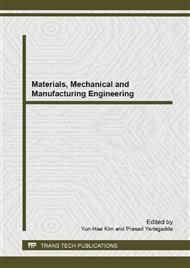[1]
Girot FA, Quenisset JM, Naslain R. Discontinuously-reinforced aluminum matrix composites. Compos Sci Technol 1987; 30: 155.
DOI: 10.1016/0266-3538(87)90007-8
Google Scholar
[2]
Ibrahim IA, Mohamed FA, Lavernia EJ. Particulate reinforced metal matrix composites-a review. J Mater Sci 1991; 26: 1137.
DOI: 10.1007/bf00544448
Google Scholar
[3]
Miracle DB. Metal matrix composites - From science to technological significance. Compos Sci Technol 2005; 65: 2526.
Google Scholar
[4]
Torralba JM, Da Costa CE, Velasco F. P/M aluminum matrix composites: an overview. J Mater Process Tech 2003; 133: 203.
Google Scholar
[5]
Rawal S. Metal-matrix composites for space applications. Jom-Us 2001; 53: 14.
Google Scholar
[6]
Ph. Lequeu PLTW. Aluminum alloy developmen for the airbus A380-part2. Advanced materials &Process 2007: 41.
Google Scholar
[7]
Tjong SC, Ma ZY. Microstructural and mechanical characteristics of in situ metal matrix composites. Mat Sci Eng R 2000; 29: 49.
Google Scholar
[8]
Mortensen A, Jin I. Solidification processing of metal matrix composites. Int Mater Rev 1992; 37: 101.
Google Scholar
[9]
Lloyd DJ. The solidification microstructure of particulate reinforced aluminium/SiC composites. Compos Sci Technol 1989; 35: 159.
DOI: 10.1016/0266-3538(89)90093-6
Google Scholar
[10]
Arsenault RJ, Shi N. Dislocation generation due to differences between the coefficients of thermal expansion. Materials Science and Engineering 1986; 81: 175.
DOI: 10.1016/0025-5416(86)90261-2
Google Scholar
[11]
Kamikawa N, Huang X, Tsuji N, Hansen N. Strengthening mechanisms in nanostructured high-purity aluminium deformed to high strain and annealed. Acta Mater 2009; 57: 4198.
DOI: 10.1016/j.actamat.2009.05.017
Google Scholar
[12]
Arsenault RJ, Wang L, Feng CR. Strengthening of composites due to microstructural changes in the matrix. Acta Metallurgica et Materialia 1991; 39: 47.
DOI: 10.1016/0956-7151(91)90327-w
Google Scholar
[13]
Wang F, Ma N, Li Y, Li X, Wang H. Impact behavior of in situ TiB2/Al composite at various temperatures. J Mater Sci 2011; 46: 5192.
DOI: 10.1007/s10853-011-5454-3
Google Scholar
[14]
Ozden S, Ekici R, Nair F. Investigation of impact behaviour of aluminium based SiC particle reinforced metal–matrix composites. 2007; 38: 484.
DOI: 10.1016/j.compositesa.2006.02.026
Google Scholar


